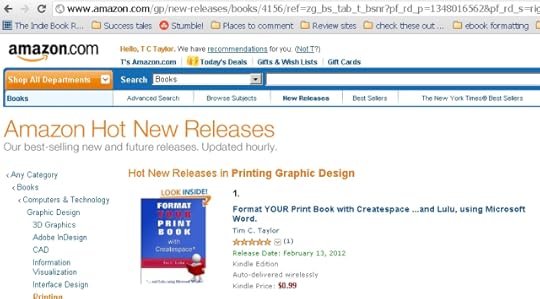Tim C. Taylor's Blog, page 15
April 13, 2012
Why writers need Lego
We’re now coming to the end of my son’s two-week Easter break from school. We went on a train, saw the animals at the zoo, and played soccer. Most of all, though, we’ve made things with Lego.

Lego truck
At my parents’ house we dug some old Lego out of the attic. I enjoyed looking at the catalogs from when I was a kid. Strangest was a leaflet from 1973 that would have been packaged with a Lego kit that belonged to one of my older brothers. In sober, Nordic wording (that didn’t quite translate into English) the Lego company explained to parents how their product was an educational tool that promoted hand-eye coordination, planning skills, and creativity. I’m sure it does all those things…
But that’s not why I build with Lego.
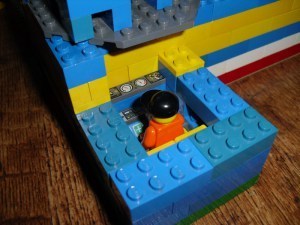
Time machine control room
When I worked in the software industry, I used to train and audit development teams to be creative in their designs by using an appropriate mix of throwaway and evolutionary prototyping. That’s just a fancy way of saying the software teams learned to start off projects straight away by building things, and rebuilding, and rebuilding again… The idea is that you’ll end up with a better product by making things and learning from doing, than kidding yourself that you can design everything on paper before you start coding. Sometimes they would make something quickly just to prove a concept or try out an idea, and then throw that design away (but retain what they had learned). That’s throwaway prototyping. It’s easier with Lego because I don’t get the commercial people complaining I’ve ‘wasted’ tens of thousands of pounds building prototypes that I’m throwing away. With evolutionary prototyping, you’ve got a slightly clearer idea of your overall design (although many of the details might still be fuzzy) and you build the next bit and the next bit until you’re done. If you realise you’ve stumbled across a better design, you just unpick a few steps and rebuild. The only difference with throwaway prototyping is that you keep you design robust.
This idea of starting off by writing, and only later stepping back and thinking about what you have learned from the process before beginning to zoom in on a final design, is common to writers too. Christopher Priest wrote an article in the current BSFA Focus magazine. He didn’t use software or Lego analogies, but he argued — actually he insisted — that once you’ve finished your first draft of a novel, you should learn what you can from that throwaway prototype, and then set to writing the novel again all the way through from beginning to end. Iterate until you reach a draft you’re satisfied with.
Prototyping isn’t as easy as it sounds. It’s easy, for example, to start off writing a throwaway prototype but then yield to the pressure to deliver it to the publisher as a finished draft. Could making things with Lego be a good exercise to learn agile development techniques for coding and writing books? Probably…
But that’s not why I build with Lego.
In my writing group, if the layout of a scene isn’t clear, our members will ask the author to go away and sketch out a plan of the setting before recrafting the scene in a more vividly realised (and consistent) location. When I get stuck describing a setting, I normally use pencil and paper, but Lego might be an excellent alternative, especially if drawing plans and elevations aren’t your thing.
Perhaps… maybe… probably… but that’s not why I build with Lego.
My reason is because it’s fun. Whether you’re a writer of science fiction adventures or a columnist for the New York Times, you got started down that road because you got a kick out of being creative. For that matter, you could be a cover artist, or developing software for the next generation of consoles, you’re creative — give yourself permission to go have fun creating!
So much of the time, writing is about editing, pacing, consistency, honing, and chasing down that one mis-spelt word that will create such a bad impression that it ruins the other 95,000. It’s worrying about how you’re going to promote your book, whether the characters are credible yet vivid, and whether you’ve got the science right about what happens when your character takes off her helmet in deep space.

A clown entertaining a stegosaur, yesterday
That’s rewarding when it works. It’s even creative. But it’s not the unconstrained creativity you can get from freeing your brain from its fetters and letting go with Lego. It’s not sprint zero.
Yesterday my son and I were building a dairy farm, complete with cows (with udders!) and a milking parlor. This morning we added a time machine to the farm, upgrading it from a dairy farm to a dino-dairy farm, and we’ve now transported our first set of dinosaurs through time to our farm.
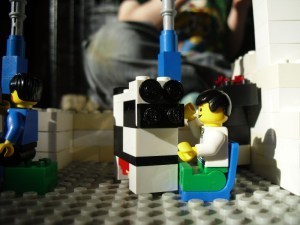
Milking time at the farm. Moo!
It doesn’t matter if the bricks aren’t the right colour, or the cows don’t have tails, because we’re letting go and having unconstrained fun.
Well, that’s not quite true. We did have an incident where a pterodactyl ate a farmer and I made the mistake of calling the pterodactyl a dinosaur, an error which my son was eager to point out. (“They aren’t dinosaurs! They’re flying reptiles, Daddy.”)
In fact, becoming a parent has convinced me in recent years that we are all of us creative; it’s just that some of us forget, and a lucky few get paid to be creative.
So plan out the scene in your book, or model the bridge you’re going to build, have some kids… do whatever it takes to give you an excuse to let yourself with Lego.
You deserve it.

Predator X
UPDATE: April 18th
Another writing analogy comes to me courtesy of author, Ian Watson. He told me recently that when editing a novel, if a scene needs more than a few lines of change then you should rewrite it completely. Otherwise it’s prone to mistakes and inconsistency, and the prose becomes unfocussed because the scene wasn’t written with a coherent vision. That’s what I’ve been arguing in software terms for years. These days we’d call it code refactoring. Software code that’s been changed, and changed, and changed, is code that becomes brittle and is likely to break, especially in large, integrated sytems where the code unit you’re tinkering with not only has to do it’s own job well, but has to co-operate with all the other code units, which are also being tinkered with. Sometimes it’s called spaghetti code.
It’s interesting that I hear the builders of prose argue for quality with a more powerful voice than builders of software code. In real world software projects, there is often a strong pressure not to refactor code from the commercial part of the organisation. We can’t afford the ‘luxury’ of refactoring, is a common argument. If we refactor then we’ll miss our deadline, is another. In my experience, the code writers have a much weaker voice than the prose writers, which means code is delivered that might work (mostly) in the short term but isn’t robust and will eventually break. (And just to balance that comment — and give a hint at how running software organisations isn’t easy — there are plenty of coders, as well as writers, who will use concepts such as refactoring as an excuse to permanently tinker and evade committing to a release.)








April 12, 2012
Great article on the wonders of the ancient world
I came across an excellent online article on SpaciousPlanet.com about the wonders of the ancient world and how they eventually met their destruction. Some lasted for many centuries and then remained in ruined form for many more centuries, often until relatively recent times.
If you wanted to read who bought the Colossus of Rhodes for scrap (!), take a look at the article here.








Kindle Freebies. FREE Book Bonanza on April 13th
Tomorrow (Friday 13th April) I'm part of a free book bonanza. Authors and small publishers are clubbing together for a chance to offer you free Kindle books through the Kindle Store (US and UK). There are books from pretty much every genre, and if you look at the science fiction section, you will see one book cover featuring dinosaur and human 'watchers'. In fact, it will look suspiciously like this picture…

Book1: The Slough of Despond
because my first novel is one of the titles being offered for free.
Take a look around and download whatever you fancy. The links will take you to the Kindle Store on amazon.com, but the books should also be free on amazon.co.uk
For we authors, it's a chance to spread the word about our books. For readers it's an opportunity to try out some new authors. So why not show up tomorrow and browse?
http://kindlefreebies.wordpress.com/








New cover artwork: better or worse?
Thogron Throatbiter acquires another fresh coat of green paint.
I usually pay other people to do my book covers these days. That's probably for the best >:-)
In the very earliest days of Greyhart Press, when it only sold short stories, I wanted to first see whether the eBooks might generate enough sales before paying for professional artwork. When I first thought of publishing eBooks, I looked at the kind of covers other authors and small publishers were using for short stories at the time… they weren't good, that's for sure.
Anyway, that proved a false economy and the level of professionalism for cover art has rocketed since early last year. The level of editing and formatting quality has risen too, though not as fast. We are in a peculiar, and (I'm sure) temporary situation where the more quality-conscious self- and small-publishers have artwork and copy-editing very nearly as good as major publishers (on average) and the internal formatting better than major publishers, especially backlist titles. Selling backlist as eBooks is compelling, but books scanned from printed books need tenacious copyediting, and those produced via print-ready PDFs need fully reformatting. It's tempting to miss out these steps.
Not all publishers cut corners like this. In fact, in recent weeks I've been delighted to help do the formatting portion of the work to help an author begin to publish some of his backlist, a laborious process that began with scanning paperbacks.
But I digress.
Of my earlier attempts at artwork, my favourite was a hand-drawn starmap, complete with knowing sci-fi references and puns in the starnames. It took me hours. The is for The Meandering Mayhem of Thogron Throatbiter, which is a humorous short story. Kind of Brian Blessed meets Warhammer 40k, while dressed like Shrek (I did an interview about it here). The alien species who populate this story are a putrid green colour, so I went to town with garish colour in the cover. I still love it, but I think you have to have read the story to appreciate the cover. Since you need to like the cover to be interested in reading the story… well, you can see why it had to go.
So I made a new cover yesterday. I went for a stock image of a spaceship. A nice one, mind. And played around with colours to put the horrid greens and yellows in, though more subtly than before. I've relied upon the title to convey the sense of tongue-in-cheek humour.
Let me know what you think.

After

Before
The Meandering Mayhem of Thogron Throatbiter is published by Greyhart Press, and is currently free pretty much everywhere, including the various Amazon sites. You can get a copy for yourself by following the 'buy' links on this page. You don't even need an eReader, as Amazon provide a good Kindle reader application for PC, Mac, iPad, iPhone & Android.








March 27, 2012
The Perils of Plotting Time Travel
By Tim C. Taylor (a version of this article was originally posted on Jeremy Bates' blog)
One of the great fantasies in fiction is to travel into the past to experience what it might have been like to live in historical worlds that we see only in history books, or to travel the other direction into the future. In most cases, authors and scriptwriters present these fantasies by simply setting the entire story in this other time: hence historical dramas and futuristic science fiction. But there's another way to present this fantasy, and that is to have your characters travel into the past or the future, usually starting their journey from a setting in today's world.
Welcome to the time travel novel!
Last month I published a time travel novel myself. It's called The Reality War. In this post, I'll share some of my experiences because plotting a time travel novel isn't always as simple as it looks.
A brief history of time travel
Most commonly the writer sets up most or all of these time-traveling characters to come from the present day so that we, the reader, identify with them. As the characters marvel at the wonders these other times present, and struggle to prosper in worlds they don't fully understand, we marvel and struggle with them. We're right in there, exploring these times as if we too are time travelers.

Quantum Leap: Time travel circa 1990
Writers have used this approach to time travel for most of the past few centuries. TV shows such as Quantum Leap, books such as A Connecticut Yankee in King Arthur's Court (1889) by Mark Twain, and films such as Back to the Future largely fit this description, though some of these stories, such as Twain's, are designed to satirize contemporary society, and by the time Quantum Leap and Back to the Future were shown, there's an increasing interest in the mechanisms and the reasons for time travel, something that has often been to the fore with the longest-running time travel saga of them all: Doctor Who (first shown in 1963, the day after President Kennedy was shot).
More recently, while many time travel stories remain content to transport the characters to an adventure in another time, others are increasingly interested in the consequences of time travel, such as the beautifully circular nature of Schwarzenegger film The Terminator, and the complicated romance of The Time Traveler's Wife (2003) by Audrey Niffenegger.
So when I started writing a time travel novel a few years ago, I first had to make some decisions about what kind of book I wanted to write.
Scientific Romance or technobabble?
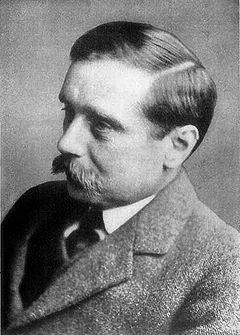
HG Wells. What a guy!
First off, I read some novels featuring time travel. It's quite a fun kind of research. Plenty of people would point to The Time Machine (1895) by HG Wells as the first modern time travel novel. Wells described his 'scientific romances' (as he called them) as changing just one thing about the modern world and seeing what would happen. In his case, that change is the time machine built by the Victorian gentleman inventor. The future worlds the inventor travels to extrapolate Wells' thinking about the class divide in the wake of the industrial revolution (Wells has the workers and the wealthy evolve into separate species), and contemporary scientific thinking about the entropic universe (in his story, the Earth of the far future is dying). While Wells makes a lot of effort to invent credible futures, he makes no attempt to explain the physics of time travel or its possible consequences. We see shiny brass control panels and levers; that's enough for Wells.
I also listened to an audio version of Kindred (1976) by Octavia Butler. Here the author takes a black woman living in 1976 California and transports her to a life of slavery in Maryland of the early 1800s. Rather than present a straight historical novel, Butler uses time travel as a literary device to transport a modern woman into the past in order to make the realities of slavery more immediate to the modern reader; we're also transported with the main character, and we also find the transition shocking.
But in Kindred, there is no attempt to cast a veil of explanation over the way in which the character time travels. There's no moment of Star Trek technobabble, where (at its worst) it suddenly occurs to the chief engineer that if we reverse the phase of the forward shield modulators, we conveniently have the capability to time travel. Butler's time travel is a literary contrivance in order to set up an otherwise impossible scenario that she wants to write a story about. We know it's contrived. Butler knows that we know it's contrived, but none of that matters. She makes such a brief reference to the traveling that we quickly accept the story conceit, and get on with enjoying what Butler wants to show us.
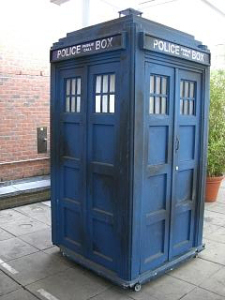
A time travel machine, yesterday.
Then there were other books I read that I'm too embarrassed to mention here. Ones that start with the worst technobabble from Star Trek, add some half-remembered terms from school such as hypotenuse and coefficient, and present that as impressive science. No, I wasn't going to take that approach with my novel. (BTW: I love Star Trek; a consequence of the Trek universe having such a vast fictional output is that inevitably are some dark corners of plotting naughtiness.)
I thought Kindred's if-I-mention-it-quickly-no-one-will-notice approach to time travel worked for that book, but was too vague for the science fiction I like to read. So to start with, HG Wells was my pilot through time, and that's not a bad thing.
How to make your reader's brain melt
Time travel can get really complicated.
I'm not talking about the mechanics of how it's done, I'm talking about the storytelling. In most novels, each scene takes place a little further along in time than the previous one. If there's a big gap, the author will probably start a new part and add something like 'Ten Years Later…' so you know there's a big jump in time. The reader is so familiar with this sequencing of scenes that he or she won't even stop to notice what the author's doing.
But with time travel, what is the correct sequence of scenes? Well, of course, there isn't one. When the characters can move backward and forward in time, it's up to the author to choose whatever sequence best fits the story they want to tell.
Sometimes the author wants to write about the dislocating effect of time travel. Well, that's easy enough: just jumble your scenes into a random order; that should do the trick. Problem is, most readers will give up if you do that; I know I would.
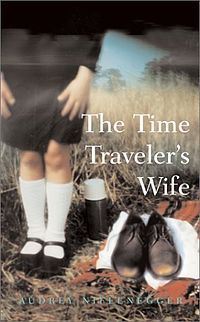
The Time Traveler's Wife: complex, but still works
The Time Traveler's Wife pushes this about as far as I think you could go. The sequence of scenes is difficult to follow, but that's okay because that book's more about the psychology of troubled relationships, with the time traveling more of a metaphor for how people in relationships often don't seem quite in phase with each other. I wanted my book to be essentially action-adventure (though a thematic connection with The Pilgrim's Progress soon became very important — but that's another post). So I knew I had to make my plot easier to follow than The Time Traveler's Wife.
That's much easier said than done. I kept a book of scrawled notes and diagrams about how my fictional world(s) worked. I needed to be clear how everything fitted together because that way I could concentrate on the parts of the story that mattered most and were most exciting. Sounds strange, perhaps, but I find the deeper my understanding of the background to a story, the more confident I am at knowing what to focus on, and what I can safely leave out.
Even so, there were two redrafts where I looked at my notes, and then scratched thick red lines through sections of the plot that were overcomplicating the story and so had to go.
But I wanted a story where time travel wasn't only an excuse to have an adventure; it was at the heart of event, it caused them.
So I couldn't ignore perhaps the most powerful — and dangerous — idea in plotting time travel novels: CAUSALITY.
Causality causes confusion
At the kind of simplified level that you and I might understand, causality is actually a pretty obvious concept. It's a fancy way of saying that cause leads to effect.
Take this example: you hold a glass vase of flowers out of the fifth-floor window. You let go… what happens?
Well, it's not a trick question. You let go — nothing resists gravity accelerating the vase toward the ground — vase hits ground — vase shatters. It's so obvious it seems a pointless waste of time describing the sequence of cause leads to effect. Cause happens first (drop the vase) followed by the effect (vase breaks).
Not so with time travel.

Welcome to my closed loop, baby!
Take the first Terminator film: John Connor leads the human resistance in the future — so a cyborg assassin goes back in time to kill John's mother, Sarah Connor — so John sends his friend, Kyle, back in time to protect his mother — which leads to Kyle getting Sarah pregnant with John — so Sarah goes into hiding and prepares to train up John to be an effective leader and fighter — which brings us back to John Connor leads the human resistance in the future — a cyborg assassin goes back in time… and so on.
In this example, causality breaks down. In other words, it is no longer true that effect always happens after cause. Humanity needs John Connor to lead the resistance (cause) which leads to Sarah preparing him for that role (effect). But the rise of the machines hasn't happened yet. The effect is occurring before the cause.
If that feels complicated, it's because it is complicated. In the world we live in, cause always appears to lead to effect; time only flows in one direction and our brains can't really cope with anything else. In The Terminator, the script cleverly implies a closed loop. If you follow events in the right sequence, as I listed them above, then it appears that effect follows cause and everything appears simpler than it really is. And yet the sequence is impossible; it's a paradox, but maybe it's just what the universe has decided to settle with. It might be impossible, but it's the most stable version of history.
That's a neat trick, so I make use of closed loops and the idea of reality settling into the most stable and least confusing version of history.
But I needed something to shatter all this neatness, to be the spanner in the works that kicks off the Reality War I write about. And for that I need a little more from PARADOX.
Professor Paradox is/ was/ will be my grandfather

Grandfathers are like chilli peppers
Let's go back to The Terminator. If Schwarzenegger's cyborg assassin succeeded in killing John Connor's mother in the past, then John would never be born — which would mean the cyborg would not be sent back in time — which means…
This is sometimes called the Grandfather Paradox. If you go back in time and kill your grandfather, then you would never have been born… in which case you couldn't have killed your grandfather… in which case you can travel back in time and kill him…
Argghhh!
Plotting with time paradoxes is like cooking with the hottest chili peppers: a supremely memorable ingredient, but use sparingly or you'll blow your readers' heads off.
But if we can time travel…
One more time travel plotting idea to consider… If time travel is possible, what's so special about the times when your story is set? Take the Victorian gentleman inventor of HG Wells. If he invented time travel in the 1890s, why don't other people invent time travel in his future? And what about the people in their future? What is so special about the 1890s that this is the only point that time travel is invented? To his credit, Wells raises this point in his novel. I think he's right to do so.
Keep watching the shadows in my novel because in The Reality War there are other people hiding there.
Conclusion: The Reality War
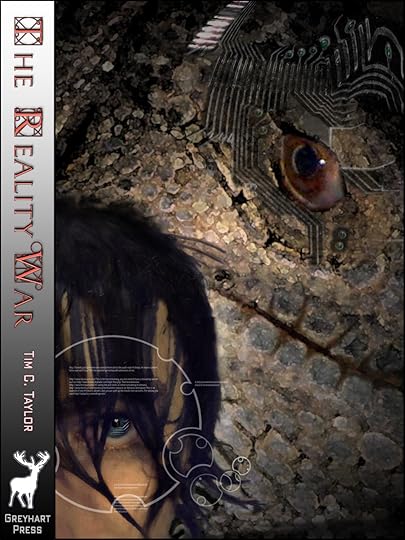
Book1: The Slough of Despond
And so you had — until a few months ago — my time travel series, entitled My Future in the Past. It has a history of simplifying and simplifying again, a big shift from events toward the effect of events on the characters. The last change of all was to the title. I tested out My Future in the Past. People thought it sounded like time-travel, but it also sounded complicated. So I simplified that too and a came up with the name The Reality War, which was more popular (especially with men, for some reason).
In conclusion, plotting a full-on time travel is not for the fainthearted There are many pitfalls and a lot of work. And when you sit back and release your novel into the world, I have no doubt that some readers will vigorously attack it because they will be convinced that's not how time travel really works.
No worries. I look forward to such discussions, because if there's one thing I've learned about writing time travel, it's that it is addictive.
About Tim C. Taylor
 Tim C. Taylor is a writer and publisher of science fiction and fantastic literature. The Reality War Book1: The Slough of Despond is his debut novel and was published on his birthday, February 9th 2012, initially as a eBook and has just come out in paperback in the US and UK. The second and concluding book will be published in the spring.
Tim C. Taylor is a writer and publisher of science fiction and fantastic literature. The Reality War Book1: The Slough of Despond is his debut novel and was published on his birthday, February 9th 2012, initially as a eBook and has just come out in paperback in the US and UK. The second and concluding book will be published in the spring.
For more information on The Reality War see http://greyhartpress.com/our-science-fiction-stories/the-reality-war-2-novel-series/
For more about Tim, follow his blog at www.timctaylor.com or send him 140 character nuggets at @TimCTaylor








March 23, 2012
Win a free copy of The Reality War over at SciYourFi
 Sci Your Fi is running an interview with me this week, and as a bonus we've teamed up to give away 15 eBooks of my time travel adventure, The Reality War. Better hurry…
Sci Your Fi is running an interview with me this week, and as a bonus we've teamed up to give away 15 eBooks of my time travel adventure, The Reality War. Better hurry…
Talking of which, the second (and final) book of The Reality War is getting very close now. All the scenes that need to have been rewritten. The ending has been revised to tie in more clearly with other books I've written or am writing. I should nail it next week and send off to the copy editor, James D. Kelker, with whom I had a great time on the first book playing with different forms of British slang to see which travelled most amusingly across the Atlantic.
 I'm a little later than I'd intended because I've been so busy doing eBook formatting and print layouts for other authors. I've worked on behalf of eight different authors this week, including one fellow I had to agree not to name. Not yet, anyway. Blimey! It's absolutely manic here at Taylor Towers.
I'm a little later than I'd intended because I've been so busy doing eBook formatting and print layouts for other authors. I've worked on behalf of eight different authors this week, including one fellow I had to agree not to name. Not yet, anyway. Blimey! It's absolutely manic here at Taylor Towers.
Oh, yes… the interview and competition, Here it is http://www.sciyourfi.blogspot.co.uk/2012/03/author-interview-tim-c-taylor.html








March 15, 2012
Who's been reading MY blog?
Kudos to WordPress.com for putting in a country widget on the site dashboard. Now I can see where people visiting my site come from. More importantly, I can show all the flags to my son (he's into flags at the moment) and WordPress pops up a view of the world highlighting where the country is.
WordPress has only been collecting data for the past three weeks, and I was astonished to learn that people from 50 countries have visited. Welcome to you all!
The breakdown is approximately 75% USA, 20% UK, 5% rest of the world — mostly Canada.

Welcome to my Indonesian visitor this week
… and just for Andrea from Chile (who can probably translate this site for visitors from most countries), here's Chile…

Andrea's neck of the woods








February 29, 2012
I'm a hot new Amazon release… official!
I was chuffed when I logged on this morning to see that my formatting book was the #1 hot new release in its category at amazon.com In the print and design section of Amazon books I was at #9 out of 3,000 books, just 5 spots below the Chicago Manual of Style.
This post is 80% boast-while-I-can but also 20% thank you, because the book started on this website and you gave me very useful tips on which topics to address. Thank you.








February 28, 2012
Format Your Book for Createspace – promotional price expiring soon
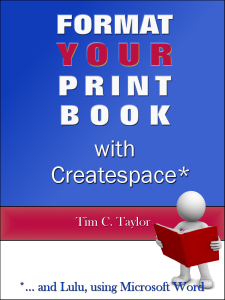 I recently published a Kindle eBook explaining how to format books for Createspace and Lulu using Microsoft Word. It's available now from Amazon at a special launch price 99c or 77p. The price will rise soon to $2.99 /£2.06, so if you were thinking of taking advantage of the special offer, do so soon. Alternatively, you could enter for a chance to win a free copy over at Librarything, where there is a member giveaway for the book. There's some competition for the prizes, though.
I recently published a Kindle eBook explaining how to format books for Createspace and Lulu using Microsoft Word. It's available now from Amazon at a special launch price 99c or 77p. The price will rise soon to $2.99 /£2.06, so if you were thinking of taking advantage of the special offer, do so soon. Alternatively, you could enter for a chance to win a free copy over at Librarything, where there is a member giveaway for the book. There's some competition for the prizes, though.
Naturally, you could hardly expect to take such a book seriously unless it was also available in print… through Createspace. That's coming soon. I had started work on this but had to postpone while I deliver a heavy workload of book-formatting commissions. I can't think of a more appropriate reason for the delay. One point to make, though. I know for a fact that you can deliver great-looking books through Createspace using nothing other than Word to prepare your manuscript (or Open Office, for that matter, though I've not done so myself). Software how-to books are another matter. I need crisper images than Word can currently deliver reliably, so I've got my trusty copy of Adobe Acrobat at the ready.








February 24, 2012
2000AD, Doctor Who, and real ale
I've just been interviewed by the wonderful Fiona McVie over at Inspiration Forum. I might have mentioned Doctor Who and real ale as my inspiration for writing science fiction.

Happy birthday
Happy birthday, Tharg. Your scrotnig publication, 2000AD (35 years old this week), gets a mention too.
Splundig Vur Thrigg from a loyal squaxx dek Thargo!
(If all this is nonsense to you, then I'm sorry, but it's not too late. The thrill-suckers have claimed you, but you can beat them off with 2000AD comic.)









